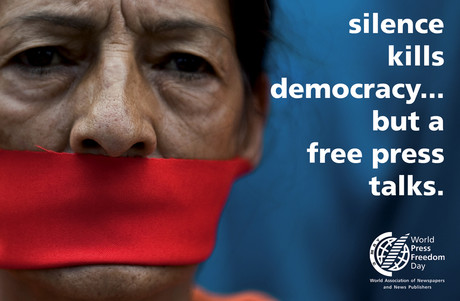The rhetoric has flowed from the very top. “We have granted a lot of freedom to the media, unlike in the old days,” said President Thein Sein during a March 2013 interview with the Democratic Voice of Burma. “The media plays an important role in the country’s development and in democratic reforms, and it needs to point out thegovernment’s weak points.”
Despite official commitments to greater press freedom, ongoing struggles such as the recent violence in central provinces and the armed conflict in the northern state of Kachin have reigned in journalists across the country.
When tensions between Muslims and Buddhists in central Myanmar erupted at the end of March, journalists found themselves in the crossfire with little protection from either the government or police.
According to the AP, anti-Muslim riots broke out in the city of Meikhtila after an argument between a Muslim shop-owner and Buddhist customers. Ethnic minority groups make up close to a third of Myanmar’s population, but in many cases are not recognized as, or given the rights of Burmese citizens . Official numbers put the death toll at 32, although some reports put the number closer to 100.
While covering the violence, a number of journalists reported to the AP that photographers’ memory cards were smashed, footage erased and threats made against them by the rioters.
Local Myanmar news service The Irrawaddy reported that a fear that authorities could not protect them caused journalists to leave the area. Reporter Francis Wade, who covers Southeast Asia for various news outlets including Al Jazeera, told WAN-IFRA via email that officials “chucked most [journalists] out of the town fairly quickly.”
An AP journalist quoted a local resident, who likened police forces to “scarecrows in a paddy field.”
While media advocacy groups argue that Burma has an obligation to ensure the security of journalists, and that President Thein Sein’s administration has not prioritized its obligation to protect the press, many say the fact that reporters are even able to access the conflict zones is progress in itself.
The situation in Kachin, however, suggests otherwise.
“The fact of the matter is that journalists have been allowed to cover the riots, quite unlike some of the restrictions imposed on reporting of the conflict with the Kachin in the northern region of the country,” said CPJ’s Southeast Asia Representative, Shawn Crispin, who recently returned from a press freedom research mission to Myanmar.
The Kachin, one of Myanmar’s many ethnic groups, occupied an autonomous state in northern Myanmar until hostilities were renewed in 2011 after Myanmar’s government broke the longstanding ceasefire with the Kachin Independence Army.
Describing his six years covering Kachin, photojournalist Ryan Libre reported hostilities towards journalists on the part of the government of Myanmar. Access to Kachin state is heavily restricted, forcing journalists like Libre to enter the war-torn area illegally through China, instead of Myanmar. While in the Kachin capital of Myitkyina, he was followed regularly, and had his hotel room broken into and his computer hacked.
In an interview with WAN-IFRA, Libre said that journalists are without a doubt prohibited from entering Kachin state across the Burmese border. “The only option is to come here illegally…if you come from the Chinese side, it’s still complicated, but it’s easier than coming from the Burmese side,” he said.
The continuing constraints for journalists are a result of coverage of the conflicts that the government finds unfavorable and irresponsible, says CPJ’s Shawn Crispin.
“If perceptions are raised that the media has somehow fanned the flames of the current sectarian violence, this is only going to add to the chorus of voices that say the media can’t handle this responsibility and that new restrictions will be imposed.”
It’s a situation that journalists find surprising, with Libre calling the freedoms that have been announced for journalists a “façade.” Still, many agree that the country is moving forward, although there is more to be done.
“Obviously, it’s been a positive change compared to where we were, say, two years ago,” said Crispin, “but the reforms (and the research has only underscored this conclusion) are so far incomplete.”


